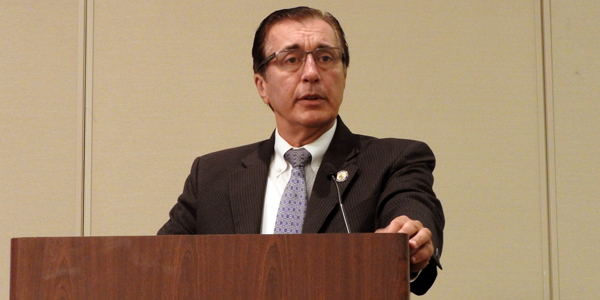By Rory D. Sweeney
TEANECK, N.J. — Joe Fiordaliso, president of New Jersey’s Board of Public Utilities, is not alone in his concerns about the state’s perceived lack of influence at PJM.
In July, Fiordaliso expressed concerns to RTO Insider that he said were making him consider having the state leave the RTO. (See NJ Regulator Threatens to Exit PJM Amid States’ Complaints.)
State Assemblyman John Burzichelli (D) told attendees at Infocast’s Offshore Wind Implementation Summit last week that he too has concerns.
“I have issues with PJM,” he said. “I’m talking about procedurally. I’m not sure they always have New Jersey issues in mind. We’re going to want a larger voice in what takes place” at PJM.
Burzichelli moved on to other energy-related topics in his featured address. But he elaborated further in an interview, saying he supports Fiordaliso’s demands for increased recognition from the RTO’s staff.
“There’s no question that they are polite and listen, but … they don’t really don’t recognize the state of New Jersey as an entity,” he said. “The short answer is I think it should change. I have a lot of faith in the leadership at the BPU. I would be supportive of the president’s lead in this.”
He suggested that state representatives should get a vote on stakeholder issues because “my observation is that [the interests of] those utilities that are based in New Jersey and New Jersey’s public interests at times are a little different.”
Fiordaliso Cites Progress
Reached on Monday, Fiordaliso said he wouldn’t respond to Burzichelli’s comments because he hadn’t yet spoken with the legislator. But he disputed an Aug. 31 report by Morning Consult that his threat to leave PJM is off the table.
“I wouldn’t say we’ve buried the hatchet. We’re moving the right direction. I think everything is on the table. Right now, I think that has eased a bit. We’re engaging in more dialogue,” he said. “I think PJM is trying to take a step in a positive direction. I think I’m starting to see a turnaround.”
On Burzichelli’s suggestion to seek voting rights at PJM, Fiordaliso acknowledged that would require states being able to become PJM members, which he said “is certainly worth looking into.”
“I think voices are heard when you do have a vote, but I’d like to look into it and see how beneficial it would be to New Jersey. … I don’t expect to win every battle, but as long as there’s an honest exchange of ideas, we can forge a relationship here.”
He said PJM showed it’s “willing to exchange ideas with us” in its comments on the Independent Power Producers of New York’s FERC complaint requesting NYISO prohibit installed capacity withdrawals from PJM into New York City across merchant transmission lines (EL18-189).
In its comments, PJM explained that curtailments necessary for reliability would happen concurrently between the merchant facilities and PJM load on a pro rata basis. This supported comments made in the docket by the BPU, along with the New Jersey Division of Rate Counsel and the Public Power Association of New Jersey. They said NYISO couldn’t consider the merchant facilities as capacity resources because they had recently reduced their PJM transmission withdrawal rights from firm to non-firm.
In fact, it was the docket in which the transmission facilities sought to downgrade their transmission rights that initially prompted Fiordaliso’s threat to leave PJM. The move left Public Service Electric and Gas to pay for most of the Bergen Linden Corridor upgrades that were designed to help facilitate “wheeling” power through northern New Jersey to New York City.
Offshore Wind
Burzichelli said his concern with PJM began with what he felt was a lack of support from the RTO in the state’s attempts to develop offshore wind during Gov. Chris Christie’s administration. The state was looking for guarantees of regional cost allocation for developing the infrastructure that would bring offshore wind generation to the RTO, but “we lost [Christie’s] attention” before anything could be built, he said. Fiordaliso’s “concerns and mine are the same; they just happen to be a separate topic,” Burzichelli said.
He also took issue with what he believed was PJM’s “failing” that required the state to act to save its nuclear plants. “As painful and as expensive as it turned out to be” to subsidize the plants, which are in his district, he “felt very strongly that it was in the public interest … because they’re reliable.”
“It’s sort of an insurance policy that has a price tag to it,” he said, predicting natural gas prices will rise once the regional glut of supply is reduced.
“It will creep. It’s just a question of when,” he said.
Burzichelli said he faults PJM rather than the nuclear owners because the owners were providing for their own interests. PJM should have revised its market rules because the power from the plants gets distributed throughout the RTO, he said.
“I have a comfort level in this case that [plant co-owner Public Service Enterprise Group] is sensitive toward ratepayers. They are also sensitive toward stockholders,” he said. “I think some of the stabilization should have been borne by a wider [RTO-wide ratepayer] base, but PJM did not step up at a pace that was satisfactory to the business model of the utility, so we acted.”




